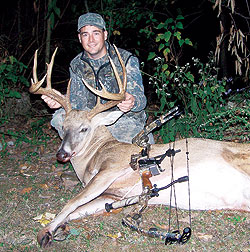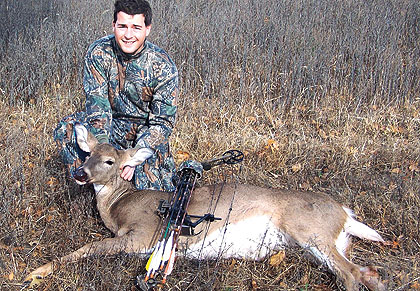November 04, 2010
When it comes to arrowing mature bucks on public lands, this hunter sees no sense in waiting for the rut
By Lee R. Mitchell

Advertisement
I might not see a lot of bucks during the early season, but when one like this comes within bow range, I need to see only one. I shot this buck in October on public land. |
Advertisement
Fast-forward seven months, a week and a half into the archery season, I'd been out only twice because the first 10 days had been unseasonably warm, and the bucks just weren't moving. Then a front moved through, plunging the temperature into the mid-50s, and I just knew this evening was going to be good.
Within mere minutes of settling into my Lone Wolf stand, I caught movement 15 yards away as a small doe materialized out of the brush and crossed in front of me. A couple of hours later I was enjoying watching two big does in front of my stand when both does whipped their heads up at the sound of something trotting behind me. Easing my head around, I almost gasped as a massive buck suddenly appeared less than 15 yards away!
Quickly coming to full draw, I was about to try to stop him when he came to a halt right behind a limb, 10 yards away. My heart was pounding as I silently willed him to take just one more step. As if on cue, he took the needed step, exposing his chest. In a flash, my arrow was on its way€¦
THE RUT AIN'T SO GREAT
I can't tell you the countless times I've read and heard bowhunters expound the virtues of hunting the rut. Well, after many years in the field, I've come to realize that the early season has consistently been one of the best times for me to arrow a good buck. How can this be when we all know THE best time is during the rut?
Well, is it really? Sure, the rut is great -- overall deer sightings go up, and bucks seemingly roam everywhere at all times of the day. However, the rut presents two drawbacks: 1) More hunters invade the woods, and 2) the bucks are much less predictable -- especially when they are running does. Let's explore these two reasons in a little more depth.
Hunting Pressure. Public lands get enough pressure as is; throw in the rut and things get crazy. Come early November, parking lots that held scarcely a truck in October suddenly are jammed, and as the days lead up to the peak, the woods get even more crowded.
Admittedly, I burn vacation time during the rut like everyone else. It is a great time to be in the woods. But the added pressure often makes it tough to catch the doe groups, so obvious in October, on their feet and moving during the day. Even worse, bucks you watched all summer and hunted in October may be miles away chasing does. The plus side is that you might see bucks you've never seen before.
Less Predictability. With food on their minds in the early season, bucks' major concern is packing on the pounds, which makes them fairly predictable. Find the food sources, learn where the bucks bed, and hunt accordingly.
Enter the rut. No longer are bucks focused on groceries. Instead, the drive to pass on their genes has kicked into high gear, and they're roaming. "Here today, gone tomorrow," pretty well describes the situation.
While I do see the vast majority of my bucks in November, often I will see them only once, and they are usually moving with a steady purpose. And they do not always cooperate by traveling through funnels as they should. Throw in a doe ready to breed, and a buck might not stand still long enough to present a shot, even if he does come within bow range.

On morning hunts during the early season, I leave the big bucks alone and focus on hunting does. |
THE EARLY-SEASON ADVANTAGE
Year in and year out, I hunt public property almost exclusively, which presents trade-offs.
On the plus side, public lands afford me lots of acreage to roam. On the minus side, older-age-class bucks are few and far between, and lots of hunters are vying for those bucks. By hunting the early season, I run into significantly fewer hunters than at any other time of the season, which I attribute to a number of things -- heat, bugs, and the oft-mentioned "October lull," when bucks supposedly go underground.
Whatever the reason, my hunting logs show that I see the most hunters during two time periods -- the overall rut period, and the last week of the season. Yes, I see hunters in the woods during the early season, but they aren't burning a lot of vacation then, and they don't spend a lot of time hunting during the week. I can't remember running into a single hunter during the week on an early-season hunt in recent years. The relatively light pressure can more than make up for the sheer numbers of bucks that will materialize in a few short weeks by allowing me to hunt relatively undisturbed bucks that are still on a somewhat predictable pattern.
TIMING AND STRATEGY
I've hunted opening days as early as September 11 and as late as October 1, and while I have seen big bucks on occasion in the mornings during early season, these sightings have been few and far between. Remember, I am talking big bucks, not the 1½ and 2½-year-olds that do routinely show up in the mornings.
Consulting my notes, I see a pattern emerging over the years -- early-season mornings are poor and evenings are good for seeing big bucks. I believe that's because most older bucks are already in their beds before dawn. Rather than risk tipping my hand and wasting potentially productive spots by bumping bucks in the dark, I reserve the mornings for hunting does in areas not frequented by bucks. In short, I simply avoid hunting early-season bucks in the mornings.
In the evenings, though, the potential reward outweighs the risk, and I hunt spots that give me a good chance of catching bucks on their feet during daylight. My strategy is relatively simple -- I set up as close as possible to where I think the bucks are bedding. My experience tells me that bucks will move a relatively short distance before dark, maybe as little as 100 yards.
If I'm not positioned almost on top of them, my odds of seeing mature bucks during legal shooting hours -- even if my stand is perfectly placed -- are nil. Fortunately, during the early season, trees still hold most of their leaves, which gives you good cover for slipping close to bedding areas undetected.
One thing of note: I keep saying bucks, not buck, because I don't subscribe to the camp that says you can consistently pattern one specific buck. I've tried over the years
and just cannot make it happen with any consistency. Instead, I look for the greatest concentration of older bucks I can find during the summer, and then I focus my hunting efforts there come fall. Statistically, it's pretty simple -- the more big bucks living in an area, the greater my odds of running across one during the season.
CONCLUSION
At the shot, the bruiser tore out of the area and immediately disappeared into a thick tangle of vegetation. Thinking I heard him go down, I couldn't believe it; no way was he down that quickly! For the next hour I was too nervous to climb down for fear of spooking him if he was indeed lying a mere stone's throw away. As the minutes passed, doubt began to creep in. Did my arrow really hit where I thought it had? Was the shot too high? Too low? Too far back? While sitting there, willing the hour to pass quickly, I was a basket case.
In the meantime, numerous deer passed my location. I could see their shadows and hear their movements. About 45 minutes into my wait, I could hear a deer snuffling around below me and then walking slowly in the direction the arrowed buck had run.
Suddenly, I heard a snort from the direction of the trailing deer. Again I heard it and suddenly the deer -- which I now knew to be a buck -- was in front of me again. For the next 15 minutes the buck paced back and forth while thrashing saplings all around me. I couldn't think of a better sign, and my spirit soared! I'd seen other bucks do this very thing when they'd come upon downed bucks. In fact, one was so fired up he wouldn't leave even when he saw me climb out of my tree. I finally had to throw a stick at him to run him off my buck!
Finally the buck settled down and went on his way. As soon as he was gone, I eased down, went to the point of impact, and immediately found blood. On pins and needles, I quietly trailed the buck and literally tripped over him in the high grass less than 30 yards away.
With my knees getting weak, I quietly said a prayer of thanks and sank into the tall grass. For a while, I just sat there admiring him, reflecting on the events of the past hour and a half, and letting my frayed nerves relax. Not bad for an early-season buck on public land!
The author is a wildlife biologist with the Department of Defense.
